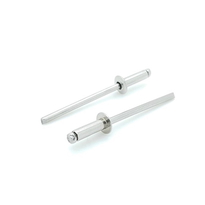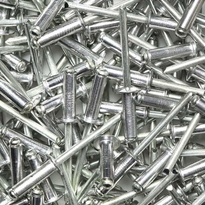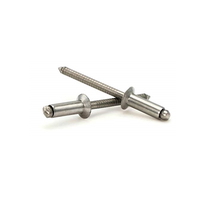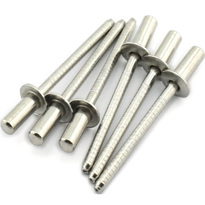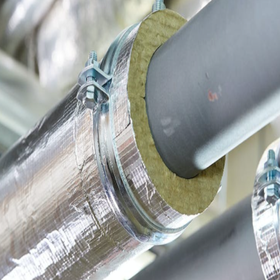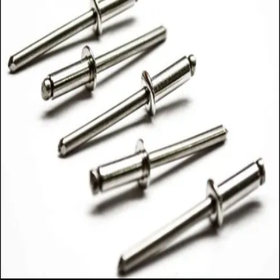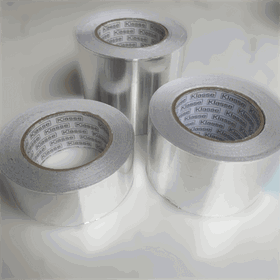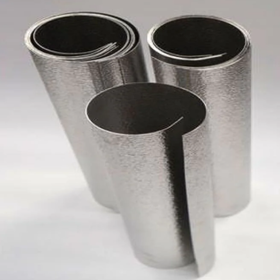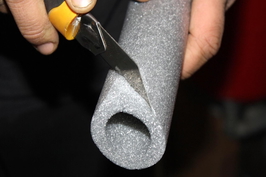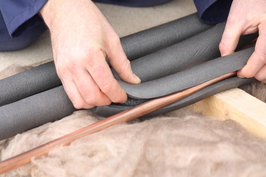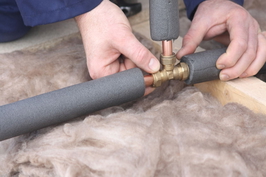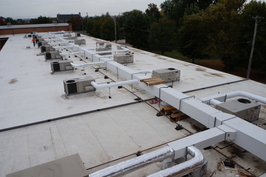Similar Categories
Rivets: What They Are, How to Use Them, and Why They Matter
Rivets are small metal fasteners that are used to join two or more materials together permanently. They are widely used in various industries, such as construction, automotive, aerospace, and marine. Rivets have many advantages over other types of fasteners, such as screws, bolts, and nails. They are economical, easy to use, resistant to vibration and corrosion, and have high strength and durability.
In this article, we will explain what rivets are, how they work, what types of rivets are available, and how to choose the right rivets for your project. We will also introduce some of the products that we offer at Buy Insulation Online, a leading online supplier of insulation and cladding materials.
What are rivets and how do they work?
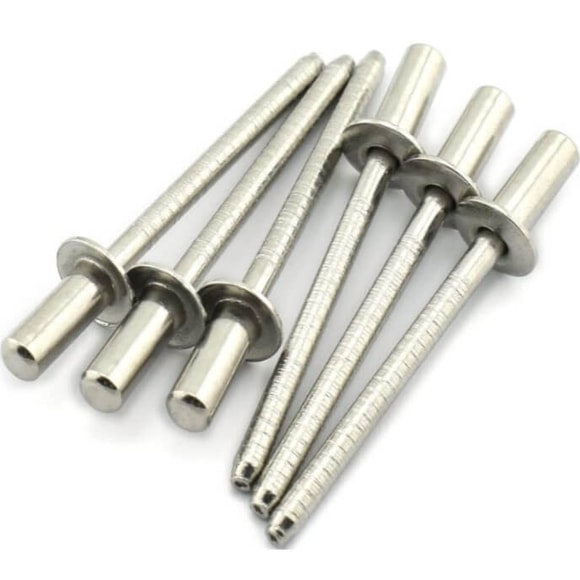 A rivet consists of a head at one end and a cylindrical body at the other end, called its shaft. The tapered end of the shaft is called the rivet’s tail. The tail looks like a metal pin. Rivets are used to join large structural pieces and small electronic assemblies.
A rivet consists of a head at one end and a cylindrical body at the other end, called its shaft. The tapered end of the shaft is called the rivet’s tail. The tail looks like a metal pin. Rivets are used to join large structural pieces and small electronic assemblies.
To use a rivet, you need to drill or punch a hole in the materials that you want to join. The hole should be slightly larger than the diameter of the rivet shaft. Then, you insert the rivet through the hole, with the head on one side and the tail on the other.
Next, you use a tool, such as a hammer or a rivet gun, to deform the tail of the rivet. This creates a second head on the opposite side of the original head, forming a tight and secure joint. The rivet now holds the materials together by its two heads, preventing it from slipping out of the hole. The rivet shaft also prevents any radial movements of the materials.
What types of rivets are available?
There are many types of rivets, depending on the shape of the head, the material of the rivet, and the method of installation. Some of the common types of rivets are:
- Solid rivets: These are the simplest and oldest type of rivets. They have a solid shaft and a round or flat head. They are installed by hammering the tail of the rivet to form a second head. Solid rivets are very strong and reliable, but they require access to both sides of the joint and a lot of force to install. They are often used in aircraft, bridges, and ships.
- Blind rivets: These are also known as pop rivets because they make a popping sound when installed. They have a hollow shaft and a dome-shaped head. They also have a metal rod, called a mandrel, that runs through the shaft. They are installed by inserting the rivet through the hole, and then pulling the mandrel with a special tool, called a riveter. This causes the tail of the rivet to expand and form a second head, while the mandrel breaks off and is discarded. Blind rivets are easy to install and only require access to one side of the joint. However, they are not as strong as solid rivets and may loosen over time. They are often used in sheet metal, plastic, and wood.
- Split rivets: These have a split or divided shaft that creates more surface area after passing through the hole. They have a sharp end that can pierce through softer materials, such as leather, wood, and plastic. They are installed by hammering the tail of the rivet to flatten it and spread the split ends. Split rivets are useful for basic repair work at home, but they are not suitable for critical applications.
- Tubular rivets: These have a hollow shaft and a round or flat head. They are similar to solid rivets, but they require less force to install. They are installed by inserting the rivet through the hole, and then using a tool, called a rivet set, to flare the tail of the rivet and form a second head. Tubular rivets are stronger than blind rivets but weaker than solid rivets. They are often used in leather goods, luggage, and shoes.
How to choose the right rivets for your project?
When choosing rivets for your project, you need to consider several factors, such as:
- The type and thickness of the materials that you want to join
- The size and shape of the hole that you need to drill or punch
- The strength and durability that you require for the joint
- The accessibility and visibility of both sides of the joint
- The appearance and aesthetics of the joint
- The cost and availability of the rivets and the tools
Generally, you should choose rivets that have the same or similar mechanical properties as the materials that you want to join. This will prevent galvanic corrosion, which occurs when two dissimilar metals are in contact with each other and an electrolyte, such as water or salt. You should also choose rivets with a slightly larger diameter than the hole, to ensure a tight fit. The length of the rivet should be enough to cover the thickness of the materials, plus some extra length for the tail deformation. The head of the rivet should be large enough to cover the hole and provide enough bearing surface for the joint.
What products do we offer at Buy Insulation Online?
 At Buy Insulation Online, we offer a range of insulation and cladding products, including rivets. We have two types of rivets that are suitable for cladding applications: aluminium dome head rivets and stainless steel dome head rivets. Both types of rivets have a dome-shaped head that provides a smooth and neat finish for the joint. They also have a blind design that allows easy installation from one side of the joint. They are compatible with most types of cladding materials, such as metal, plastic, and composite.
At Buy Insulation Online, we offer a range of insulation and cladding products, including rivets. We have two types of rivets that are suitable for cladding applications: aluminium dome head rivets and stainless steel dome head rivets. Both types of rivets have a dome-shaped head that provides a smooth and neat finish for the joint. They also have a blind design that allows easy installation from one side of the joint. They are compatible with most types of cladding materials, such as metal, plastic, and composite.
Enhance the durability and integrity of your projects with our Aluminium Dome Head Rivets, sized at 3.2 x 0.8mm and supplied in boxes of 1000 pieces each. Crafted from top-quality aluminium, these rivets are ideal for a myriad of applications, offering a secure, low-profile connection suitable for both commercial and domestic projects. Their superior tensile strength ensures a reliable and robust hold, perfect for fixing various cladding materials. Not only do these rivets provide a clean and professional finish to your work, but they also boast rust-proof and corrosion-resistant properties, guaranteeing lasting quality and a seamless installation for stucco aluminium cladding and pipe insulation. Trust in these high-quality dome head rivets for a sturdy and polished result in all your fastening needs.
Experience durable and efficient cladding installations with these Stainless Steel Dome Head Rivets. Offering a robust grip and a smooth finish, these high-quality 3.2 x 0.8mm rivets effortlessly connect cladding materials in residential and commercial settings. With their rustproof and corrosion-resistant nature, they ensure long-lasting reliability and security. These dome head rivets boast superior tensile strength, providing a clean, secure closure for permanent fastening applications. Each box contains 1,000 pieces of top-grade stainless-steel rivets, perfect for achieving impeccable results in pipe insulation cladding, delivering both functionality and professional aesthetic touch.
You can order our rivets online from our website Buy Insulation Online, we offer fast and free delivery on selected technical insulation products on orders above £125 Ex. Vat. We also offer a 14-day return policy for unused and undamaged products. If you have any questions or need any advice, you can contact us by phone, email, or live chat. We are happy to help you with your cladding project.
Conclusion
Rivets are versatile and reliable fasteners that can join various materials together permanently. They have many benefits, such as being economical, easy to use, resistant to vibration and corrosion, and having high strength and durability. There are many types of rivets, depending on the shape of the head, the material of the rivet, and the method of installation.
It would be best if you chose the right rivets for your project, based on the type and thickness of the materials, the size and shape of the hole, the strength and durability of the joint, the accessibility and visibility of both sides of the joint, the appearance and aesthetics of the joint, and the cost and availability of the rivets and the tools.
At Buy Insulation Online, we offer aluminium dome head rivets and stainless-steel dome head rivets that are suitable for cladding applications. You can order them online from our website, and enjoy fast and free delivery, a 14-day return policy, and friendly customer service.
